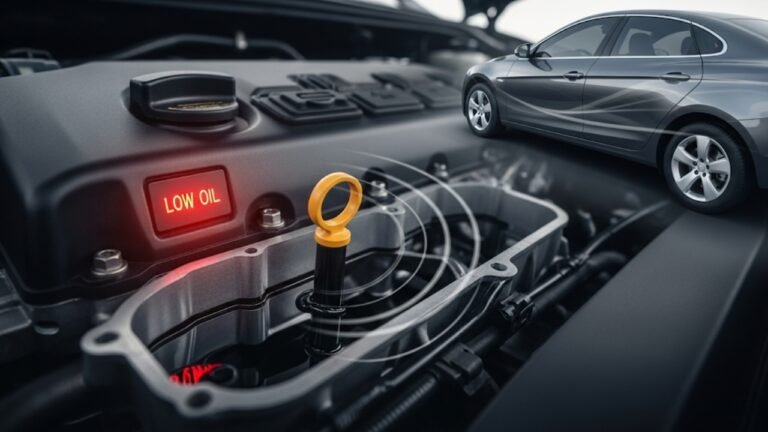What to Do If There’s Too Much Oil in Car

We all want our cars to run smoothly. Oil is like the lifeblood of your engine—without it, things can go downhill fast. But here’s the catch: too much oil can be just as bad as not enough. If you’re here because you searched what to do if there’s too much oil in car, you’re already taking the first right step.
I still remember the day I went for a routine oil top-up in my Honda Civic. The guy at the quick-lube place smiled and said, “All done.” But when I checked the dipstick later—boom! The oil level was way above the “MAX” mark. I panicked. Should I drive? Drain it? Was my engine ruined?
You’re not alone if you’re feeling confused. A lot of people make this mistake—either at a shop or when doing a DIY oil change. So let’s break it down, step by step. We’ll cover the symptoms of overfilled oil, why it’s a big deal, and exactly what to do if there’s too much oil in car.
This article is like a conversation with a car-savvy friend. No confusing jargon. Just real talk.
In This Article
- 1 How to Tell If There’s Too Much Oil in Your Car
- 2 Why Too Much Oil Is Dangerous for Your Engine
- 3 First Things First: Stop Driving Immediately
- 4 Draining the Excess Oil: Easy Methods You Can Try
- 5 How to Prevent Overfilling Oil in the Future
- 6 Signs That Damage May Already Be Done
- 7 FAQs: Quick Answers About Overfilled Oil
- 8 Final Thoughts: What You Should Remember
How to Tell If There’s Too Much Oil in Your Car

Here are a few simple ways to tell if your oil is overfilled:
-
Check the dipstick: Pull it out, wipe it clean, reinsert, and pull again. If the oil level is past the “MAX” mark, you likely have too much oil.
-
Look for white or blue smoke from the tailpipe. That’s a tell-tale sign the oil is burning where it shouldn’t be.
-
Engine misfire or rough idle: Extra oil can mess with spark plugs and cause misfires.
-
Oil leaks under your car even if the drain plug is tight.
-
Burning oil smell from the engine bay.
Too much oil sounds harmless, right? But here’s the reality: when there’s excess oil, it gets whipped into a frothy mess by the crankshaft. That foam doesn’t lubricate like it should. Instead, it causes friction, heat, and wear.
If you’re noticing any of these symptoms, it’s time to act fast. This isn’t something you should ignore for a week or two. Acting early could save your engine.
Why Too Much Oil Is Dangerous for Your Engine
Think of your engine like a chef’s kitchen. Oil is the butter—just enough makes things perfect. But too much? It ruins the recipe. Similarly, too much oil in car can create a chain reaction of bad outcomes.
Here’s what might happen when you overfill:
-
The crankshaft churns the oil into foam
-
Air bubbles reduce lubrication
-
Oil pressure increases dangerously
-
Seals and gaskets might blow out
-
Catalytic converter damage due to oil burning
-
Engine components may wear prematurely
Table: Effects of Overfilled Oil vs. Proper Oil Level
| Condition | Normal Oil Level | Too Much Oil |
|---|---|---|
| Engine Lubrication | Smooth and consistent | Foam and air bubbles reduce protection |
| Oil Pressure | Within normal range | Can become too high |
| Engine Temperature | Regulated by clean oil flow | May rise due to friction |
| Risk of Leaks | Low | High—blown seals or gaskets |
| Engine Health | Long-lasting | Increased wear and tear |
Now imagine doing 60 mph on the freeway with foamy oil running through your engine. It’s like trying to deep-fry a steak in soap suds. Things will go wrong—fast.
That’s why if you’re wondering what to do if there’s too much oil in car, the short answer is: fix it now, not later.
First Things First: Stop Driving Immediately
If you just realized your oil is overfilled and you’re parked in your driveway, you’re in luck. But if you’re already on the road, the best thing you can do is pull over safely. Do not keep driving.
When my friend overfilled his truck’s oil during a camping trip, he kept driving to “burn it off.” Big mistake. His spark plugs fouled. The engine overheated. The repair bill? Over $1,200.
So here’s the takeaway:
Stop driving. Let the engine cool. Then check the oil level with the dipstick. If it’s high, don’t assume it’ll fix itself. It won’t.
Also, don’t try weird hacks like poking holes or cracking the oil filter. You’ll cause more harm than good. Instead, take a measured approach—which we’ll cover in the next section.
Draining the Excess Oil: Easy Methods You Can Try
Okay, you’ve confirmed the issue. You’re calm. And now you’re wondering what to do if there’s too much oil in car. The goal is simple: remove the extra oil without causing a mess or damage.
Here are three methods:
1. Use an Oil Extractor Pump
This is my favorite tool. It’s like a turkey baster for cars. You insert the tube into the dipstick hole, pump out the oil, and monitor the level.
-
Clean, easy, no jacks needed
-
Great for small overfills (up to 1 quart)
-
Cheap—around $20 at auto parts stores
2. Crack the Drain Plug Slightly
Only if you’re confident. Slightly loosen the oil plug and let a small amount drip into a pan. Tighten and check the dipstick often. Repeat until the level is right.
Warning: Wear gloves. Don’t do this if the engine is hot. One wrong move, and all your oil could drain out.
3. Full Oil Change (When in Doubt)
If you’re unsure how much oil is extra or the oil is already foamy, do a complete oil change.
-
Drain all the oil
-
Replace with the correct amount
-
Swap the filter while you’re at it
This method costs a bit more but guarantees peace of mind. Plus, you can be sure you’re not running with oil full of air or metal particles.
Whichever method you choose, always recheck your dipstick and let the engine run for a few minutes before driving again.
How to Prevent Overfilling Oil in the Future
Prevention is better than repairs—especially when the repair could cost thousands. If you’ve already dealt with the stress of too much oil, you’ll want to make sure it never happens again. The good news? It’s easy to avoid.
Here’s how to keep your oil level just right:
-
Know your oil capacity: Every car has a specific oil capacity (usually in your owner’s manual). It’s often between 4 and 6 quarts.
-
Measure carefully: Don’t just dump in a full bottle. Pour slowly, check the dipstick after each quart, and top off as needed.
-
Wait after adding oil: After pouring oil, give it 5–10 minutes to settle before checking the dipstick again.
-
Use a funnel: Spills and poor measurements often come from pouring too fast. A funnel gives you control.
-
Avoid trusting others blindly: Double-check your oil level after getting service—even from a professional.
I once had a mechanic overfill my mom’s Toyota Camry during a quick lube service. Thankfully, we caught it early. But that experience taught me to never assume it’s done right. A quick dipstick check takes 30 seconds—and it could save your engine.
So if you’re searching what to do if there’s too much oil in car, the long-term fix is just being a little more mindful during every oil change.
Signs That Damage May Already Be Done
If your car ran for a while with too much oil, you may be wondering: “Is my engine okay?” That’s a valid question. While some overfill cases end without lasting harm, others aren’t so lucky.
Here are signs your engine might already be affected:
-
Check engine light comes on
-
Excess exhaust smoke (white or blue) lingers
-
Strange knocking or ticking noises from under the hood
-
Oil leaks begin suddenly after an overfill
-
Poor fuel economy even after draining the excess oil
-
Rough idling or stalling
If you’re seeing these symptoms after fixing the oil level, it’s a good idea to get your engine inspected. A mechanic can check your spark plugs, catalytic converter, gaskets, and seals.
Think of your car like your body. If you eat too much salt once, you’ll be fine. But if you keep doing it, your health declines. Too much oil in car is kind of the same—it stresses out the system. Catch it early, and there’s a good chance everything’s still okay.
FAQs: Quick Answers About Overfilled Oil
1. Can I drive a short distance with too much oil in the engine?
Only if it’s barely above the max line. But even then, it’s risky. If it’s significantly over, don’t drive at all. Drain it first.
2. Will too much oil cause my car not to start?
Yes, in some cases. If oil fouls the spark plugs or floods the cylinders, it can prevent ignition.
3. How do I know how much oil is too much?
Anything over the “MAX” line on the dipstick is too much. Even 1/2 quart extra can cause issues in modern engines.
4. Can overfilled oil damage my turbocharger?
Definitely. Too much oil can force its way into the turbo system, damaging seals and affecting boost pressure.
5. Is it okay to let a mechanic handle this, or should I DIY?
If you’re not confident, a mechanic is a smart choice. But if you have basic tools and know-how, removing extra oil is a simple task.
6. How long does it take for symptoms to show after overfilling oil?
Sometimes immediately (smoke, leaks), sometimes after several days (rough idle, misfire). Don’t wait for symptoms—check and fix it early.
7. Does oil expand when hot, causing false dipstick readings?
Yes, oil expands slightly when warm. Always check your oil level when the engine is cool for the most accurate reading.
Final Thoughts: What You Should Remember
If there’s one thing you take away from this guide, let it be this: Too much of a good thing can still be harmful. Oil is vital, but balance is key. Your engine depends on it.
The moment you notice something’s off, stop. Breathe. Pop the hood and check the dipstick. If the level’s too high, you now know exactly what to do if there’s too much oil in car.
Here’s a quick recap:
-
Stop driving immediately if the oil is overfilled
-
Check for symptoms like smoke, smell, or leaks
-
Drain the extra oil using an extractor or by loosening the plug
-
Monitor your car afterward for signs of lasting damage
-
Prevent it in the future by measuring carefully and checking after service
Car problems can be overwhelming, but knowledge gives you power. A little confidence and care can keep your car running smoothly for years. And remember—there’s no shame in making a mistake. We’ve all been there. The best thing you can do is learn from it and help others avoid the same issue.
Now go check that dipstick and give your car the love it deserves.






